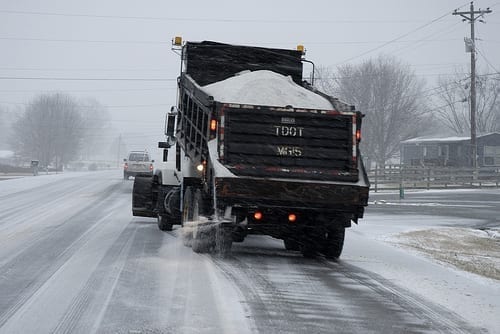Winter weather makes the roads more dangerous for everyone. For the biggest vehicles on the road, however, cold weather conditions can be especially hazardous.
Commercial trucks are easily the most dangerous vehicles on the road. Large and frequently fast-moving, these vehicles can be difficult to stop in any conditions. Due to their considerable weight, their crash force is massive, even when traveling at relatively low speeds. As such, being involved in a truck accident is always devastating. These collisions often lead to road closures, debilitating injuries, and death.
During the winter, sharing the road with 18-wheelers, garbage trucks, and other large-sized commercial vehicles can be especially risky. Not only are they more prone to accidents in the winter, but the effects of these events can be far greater in magnitude.
Why Winter Makes Commercial Trucks More Dangerous
All vehicles have a hard time standing up to winter road conditions [source]. Driving surfaces tend to be slick, covered in ice and snow, or coated in slush and mud. Even for small-sized passenger vehicles stopping distances are greatly increased. This necessitates slower driving speeds, greater caution, and refined driving tactics.
For commercial truckers, their larger vehicles intensify these changes. Large trucks experience even greater increases in their stopping distances given that it takes more traction and friction to slow their wheels down. Commercial truckers are often advised to anticipate needing 10 times the normal stopping distance during cold weather to avoid collision.
When these vehicles are hauling heavy trailers, strong winds can set them off balance and cause them to sway. It takes ample experience to move across snowy or icy terrain while balancing heavy cargo and negotiating tough traffic conditions.
Inherent Dangers of the Trucking Industry During All Four Seasons
The commercial trucking industry has a lengthy list of well-known dangers that exist year-round. For instance, given that most truckers are paid according to distance driven rather than hours logged, they usually have an incentive to drive fast and to go further than is considered safe. Some truckers work as many as eight days straight while covering up to 500 miles per day.
Loneliness, boredom, and general malaise are believed to contribute to widespread alcohol or drug use throughout the industry. To stay awake longer, feel more alert, and keep themselves entertained, some truckers use stimulants like cocaine and meth while on the job (source: https://www.cohenjaffe.com/areas-we-serve/new-hyde-park-ny/truck-accident-lawyer/).
Given the amount of distance they cover, not all truckers have the opportunity to make sure that their trucks are always perfectly maintained. Many of the shredded, blown-out tires that lie discarded on the side of the freeway come from large, commercial vehicles.

Moreover, worn tires are hardly the only maintenance-related problem that these vehicles may be facing. Unfortunately, all of these pre-existing issues within the trucking industry become far more hazardous when the challenges of winter road conditions are involved. These and other factors contribute to:
- An increased likelihood of speeding
- Aggressive driving tactics such as overtaking
- Loss of focus resulting from lack of sleep or substance abuse
- Major mechanical problems while driving caused by insufficient maintenance
It’s also important to note that commercial truckers have to account for the nervousness, lack of skill, and lack of focus of other drivers around them. Just as commercial trucks are more prone to sliding on icy surfaces, fast-moving passenger vehicles also face winter driving hazards such as low visibility, longer stopping distances, and less traction and control.
Understanding the Responsibilities of Trucking Companies
Commercial trucking companies must have plans in place for mitigating the dangers that their vehicles present year-round. These include:
- Testing drivers for substance use
- Limiting the number of allowed driving hours
- Using technologies such as speed limiters to prevent speeding
- Properly maintaining trucks at regular intervals
However, due to the increased range of challenges that winter driving presents, these entities must have additional strategies in place for further mitigation.
Trucking companies must equip their vehicles with weather appropriate tires and tire accessories, providing real-time routing and real-time weather information that allows truckers to choose the safest driving courses, and ensure that their drivers are well-prepared for all challenges, events, and situations.
Winter weather makes the roads more dangerous for everyone. For the biggest vehicles on the road, however, cold weather conditions can be especially hazardous. With the right mitigation efforts in place, commercial trucks have a much higher likelihood of making it from point to point without causing accidents, injuries, or loss of life.


Join the conversation!